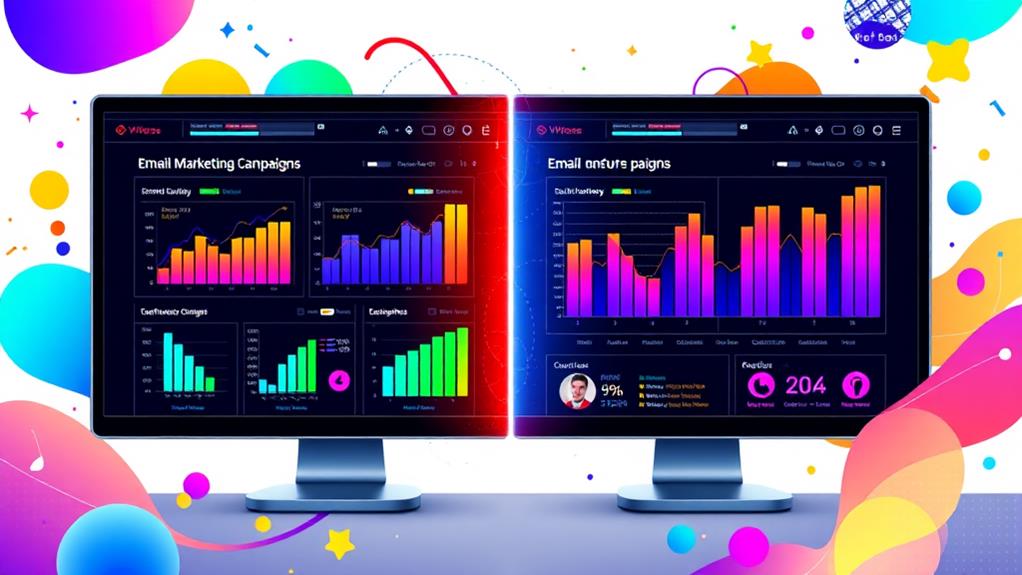Advanced email marketing strategies are pivotal for e-commerce growth, focusing on personalization, segmentation, and automation. Personalization can boost conversion rates by up to 202%, while segmentation can increase click-through rates by 100.95%. Automated campaigns drive 320% more revenue than their non-automated counterparts, ensuring that resources are effectively utilized. Dynamic content strategies, such as real-time product recommendations, greatly enhance engagement and conversion metrics. Meanwhile, optimizing subject lines with personalized and urgency-driven content can raise open rates by 26%. Addressing cart abandonment through automated email series can recover a considerable portion of lost sales. Discover how these strategies can transform your business.
Key Takeaways
- Utilize personalization and segmentation to boost open rates by 26% and conversion rates by 202%.
- Implement dynamic content strategies to enhance engagement through personalized product recommendations and real-time updates.
- Leverage cart abandonment solutions with automated email series to recover up to 30% of lost sales.
- Optimize subject lines using numbers, urgency phrases, and personalization for a 36% higher open rate.
- Employ automation for trigger-based messaging, achieving open rates of up to 80% and enhancing efficiency.
Personalization and Segmentation
To kick off enhancing email marketing effectiveness, incorporating personalization and segmentation strategies is paramount. Personalization in emails considerably boosts open rates by 26%, while tailored messaging leads to conversion rates 202% higher than generic approaches. The success of these strategies hinges on the strategic use of data analytics to understand customer behavior. By leveraging behavior-based data, marketers can deliver highly relevant and engaging content, aligning with the 71% of consumers who expect customized experiences.
Segmentation, when executed effectively, can achieve a click-through rate (CTR) 100.95% higher than non-segmented campaigns. This underscores the critical role of targeted messaging based on customer behavior insights. By utilizing data analytics, marketers can segment audiences according to purchase history, browsing behavior, and demographics. Such precision enables the identification of high-value customer groups, allowing for optimized email marketing strategies.
Moreover, implementing behavior-driven tactics, like cart abandonment emails, can recover sales from 70% of abandoned carts. These personalized follow-ups highlight the importance of data-driven strategies in re-engaging potential customers.
Structured planning and a customer-focused approach guarantee that personalization and segmentation remain integral to driving e-commerce growth through effective email marketing.
Optimizing Subject Lines
In the domain of email marketing, optimizing subject lines plays a significant role in capturing the recipient's attention and boosting open rates. Data reveals that personalized subject lines can lead to a 26% increase in open rates, making personalization a key tactic.
Furthermore, subject line testing through A/B testing is essential for strategic planning. This method allows marketers to determine the most compelling wording, with findings indicating that urgency tactics can enhance open rates by as much as 22%.
Incorporating numbers or statistics is another effective strategy, with subject lines featuring numerical data achieving a 36% higher open rate. This approach caters to the data-driven preferences of many recipients.
Additionally, the creation of urgency through phrases like "Limited Time Offer" or "Last Chance" is shown to raise open rates by 20%. These urgency tactics leverage the psychological principle of scarcity, encouraging quicker engagement.
The ideal subject line length is between 41 to 50 characters, ensuring maximized engagement. This length balances information delivery with brevity, preventing truncation across various devices.
Effective Use of Automation
Harnessing the power of automation in email marketing can greatly enhance campaign efficiency, with data showing automated emails generate 320% more revenue compared to non-automated counterparts.
By leveraging trigger-based messaging, businesses can achieve impressive open rates of up to 80% for welcome emails and recover 70% of abandoned carts, directly influencing conversion rates.
Strategically implementing these automation tools not only optimizes resource allocation but also strengthens customer engagement through personalized, timely interactions.
Automated Campaign Efficiency
Embracing automation in email marketing is a strategic move that yields substantial dividends, with data indicating a potential 320% increase in revenue for e-commerce businesses.
Automation enhances campaign performance by leveraging automated analytics to provide insights into customer behavior, allowing businesses to fine-tune their strategies for peak engagement. By using automated welcome email series, e-commerce platforms can capitalize on an impressive average open rate of 63.91% and a click-through rate of 14.34%, effectively engaging new subscribers from their initial interactions.
Automation further bolsters campaign efficiency through the deployment of cart abandonment emails, which achieve an average open rate of 41.18% and a click rate of 9.50%.
These metrics underscore the importance of timely interventions in recovering potential lost sales, ultimately driving revenue growth. Automated analytics allow businesses to monitor these campaigns closely, enabling data-driven adjustments that maximize effectiveness.
Trigger-Based Messaging
Building on the efficiency of automated campaigns, trigger-based messaging emerges as a powerful tool in the arsenal of email marketing strategies. By leveraging customer behavior data, businesses can utilize trigger analysis to send timely and personalized emails, resulting in a significant increase in engagement and conversion rates. Automated emails are reported to generate 320% more revenue than their non-automated counterparts, demonstrating the effectiveness of this method.
Common triggers such as cart abandonment, product views, and post-purchase actions provide essential insights into customer intent. Timing strategies are vital; for instance, a series of cart abandonment emails can recover up to 70% of lost sales, with an impressive average open rate of 41.18%. These timely reminders resonate with customers, increasing the likelihood of conversion.
Automation tools facilitate the creation of personalized follow-up sequences, nurturing leads throughout the customer journey and enhancing retention rates. This strategic approach not only boosts engagement but also increases customer lifetime value.
To maintain effectiveness, regular analysis of triggered email performance metrics, including open and click-through rates, is necessary. This ongoing evaluation guarantees that messages remain relevant and impactful, driving sustained e-commerce growth.
Dynamic Content Strategies
Dynamic content strategies are essential for enhancing email marketing effectiveness by integrating personalized product recommendations, triggered email responses, and real-time content updates.
By analyzing user behavior, businesses can precisely target their audience, leading to a significant increase in engagement and conversion metrics.
Implementing these strategies not only boosts ROI but also fosters stronger customer relationships through tailored, relevant communications.
Personalized Product Recommendations
While the digital landscape rapidly evolves, personalized product recommendations leveraging dynamic content strategies have emerged as a cornerstone of effective email marketing. By conducting user behavior analysis and customer journey mapping, businesses can craft emails that resonate with individual preferences, markedly boosting engagement.
Data shows that personalized emails with tailored offers can increase click-through rates by 202%. This is achieved by integrating dynamic content that adjusts email messaging in real-time based on user interactions, leading to a remarkable 100% increase in ROI compared to generic outreach.
Strategic segmentation of audiences using purchase history and browsing behavior is vital. It not only fosters a 71% higher conversion rate but also meets consumer expectations for personalized experiences. The use of first-party and zero-party data strengthens these recommendations, with 80% of consumers more inclined to purchase when offered suggestions that align with their preferences.
To optimize the effectiveness of personalized product recommendations, A/B testing is essential. Emails featuring personalized subject lines achieve a 26% higher open rate, driving further engagement and sales.
Consequently, the meticulous application of dynamic content strategies in personalized emails is indispensable for e-commerce growth.
Triggered Email Responses
Personalized product recommendations have set the stage for the next powerful tool in email marketing: triggered email responses. These responses leverage behavioral triggers to deliver timely and relevant communications that considerably enhance customer engagement.
By analyzing user behavior data, businesses can strategically plan emails that respond to specific customer actions, resulting in a staggering 152% higher open rate compared to standard campaigns. This approach guarantees that emails are not only opened but also acted upon, thereby maximizing their impact.
Dynamic content strategies within triggered emails play a vital role in this process. Tailored product recommendations, for example, have been shown to double email ROI by engaging customers more effectively.
One of the most compelling applications is in cart abandonment scenarios, where triggered emails can recover up to 30% of lost sales. Timing is essential; sending reminders within an hour of abandonment yields the highest conversion rates.
Automation tools streamline the process of implementing triggered responses, guaranteeing that content is delivered precisely when it is most relevant, based on behavioral triggers.
This not only saves time but also enhances customer satisfaction by providing a seamless and personalized experience, ultimately generating three times more revenue than traditional promotional emails.
Real-Time Content Updates
Harnessing the power of real-time content updates is revolutionizing email marketing by enabling e-commerce businesses to deliver highly tailored and timely messages.
Dynamic content strategies allow brands to customize email content instantly, reflecting user behavior and preferences. This approach considerably enhances content relevance, driving a 100% increase in email ROI through personalized product recommendations and exclusive offers. By aligning with individual shopping habits, businesses see a 17% higher response rate, demonstrating the effectiveness of personalized snippets in capturing subscriber attention.
Real-time content updates also facilitate urgency creation, an essential factor in influencing consumer behavior. By integrating limited-time offers or showcasing current product availability, e-commerce brands can prompt quicker purchase decisions, leading to a substantial 29% increase in open rates compared to static emails.
This immediate relevance not only boosts engagement but also fosters a sense of exclusivity and immediacy.
Moreover, the ability to optimize content dynamically guarantees ongoing improvement in email marketing strategies. By analyzing performance metrics, businesses can refine their approach in real-time, tailoring messages to better meet audience needs.
This strategic planning not only enhances customer satisfaction but also strengthens brand loyalty, driving sustainable e-commerce growth.
Cart Abandonment Solutions
In the bustling world of e-commerce, cart abandonment presents a notable challenge, with an average rate of 69.9% underscoring the urgency for strategic recovery solutions. One effective approach involves sending a series of cart abandonment emails, which boast an average open rate of 41.18% and a click rate of 9.50%. These emails are essential for incentivizing customers, with well-timed incentive offers such as discounts or free shipping acting as persuasive tools to entice them back to complete their purchases.
| Strategy Component | Details |
|---|---|
| Average Open Rate | 41.18% |
| Average Click Rate | 9.50% |
| Recommended Email Series | 3-4 messages |
| Incentive Offers | Discounts, Free Shipping |
To maximize the effectiveness of these emails, a series of three to four emails should be dispatched with strategic recovery timing to guarantee they remain fresh in the customer's mind. Automating this process can streamline the workflow, confirming timely follow-ups. By focusing on offering well-crafted incentive offers at the right moments, e-commerce businesses can greatly enhance conversion rates and recapture lost sales. Streamlining these efforts with automation further guarantees a swift response, improving overall recovery rates and boosting revenue. This data-driven approach underscores the importance of strategic planning in mitigating cart abandonment challenges.
Enhancing Customer Engagement
The importance of customer engagement lies at the heart of successful email marketing strategies, where data-driven insights pave the way for tailored interactions. Personalized emails are instrumental in this regard, achieving a 17% higher response rate compared to generic content.
By leveraging customer feedback, businesses can craft customized snippets that resonate more deeply with recipients. Welcome email series further establish strong initial connections, boasting an average open rate of 63.91% and a click-through rate of 14.34%, setting a solid foundation for long-term engagement.
Strategic use of engagement emails, such as newsletters featuring personalized recommendations, fosters brand trust and enhances customer retention. These emails deliver relevant content, aligning with customer preferences and behaviors gleaned from segmentation efforts.
Segmenting email lists based on customer behavior allows for targeted messaging that greatly improves the customer experience and satisfaction.
Moreover, A/B testing emerges as a critical tool in optimizing engagement metrics. Testing different email elements, like subject lines and CTAs, can yield substantial improvements, with a single clear CTA boosting clicks by 371%.
Frequently Asked Questions
How Can Email Marketing Improve Brand Awareness in E-Commerce?
Email marketing enhances brand awareness by utilizing brand storytelling to create engaging narratives. Strategic audience segmentation guarantees personalized messaging, improving customer engagement. Data-driven insights guide content optimization, fostering stronger brand connections and driving e-commerce growth effectively.
What Role Do Customer Reviews Play in Email Marketing Strategies?
Customer reviews play a pivotal role in email marketing strategies by providing authentic customer feedback and enhancing trust. Implementing review incentives encourages more reviews, fostering strategic planning and data-driven adjustments to improve customer-focused marketing efforts.
How Does Email Frequency Impact E-Commerce Customer Retention?
Email frequency directly influences e-commerce customer retention by aligning with customer preferences. Strategic email segmentation enables personalized communication, optimizing engagement rates. Data-driven analysis guarantees frequency adjustments enhance customer satisfaction, fostering loyalty and long-term relationship growth.
What Are the Best Practices for Email List Growth in E-Commerce?
To effectively grow an email list in e-commerce, implement strategic planning utilizing incentive offers and lead magnets. This data-driven approach enhances customer engagement, attracting potential subscribers through value propositions that align with consumer interests and purchasing behavior.
How Important Is Mobile Optimization for E-Commerce Email Campaigns?
Mobile optimization is essential, with 61% of emails opened on mobile devices. Strategic planning should prioritize mobile design to enhance user experience, ensuring accessibility and engagement, thereby driving higher conversion rates in e-commerce email campaigns.
Conclusion
The deployment of advanced email marketing strategies in e-commerce, centered on personalization and segmentation, optimization of subject lines, effective automation, dynamic content strategies, and cart abandonment solutions, greatly enhances customer engagement and drives growth. Data-driven insights facilitate strategic planning, enabling tailored communication that resonates with target audiences. By leveraging these approaches, e-commerce businesses can maximize customer lifetime value and conversion rates, thereby establishing a competitive edge in a rapidly evolving digital marketplace.




